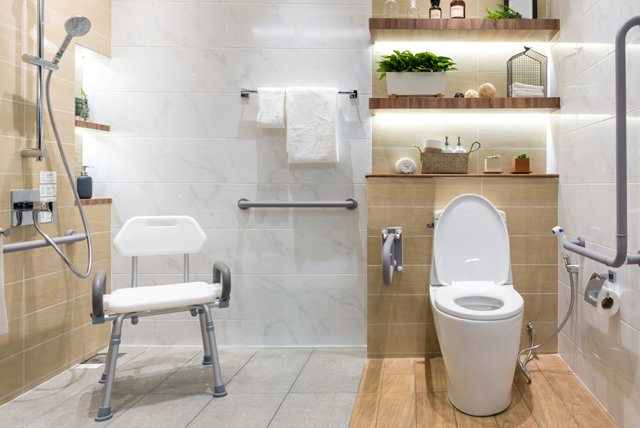5 Simple Home Modifications to Consider for Aging in Place
In planning their future, it has become increasingly common for older people to stay in their own homes rather than move into senior living communities. According to a 2018 AARP survey, 3 out of 4 adults ages 50 and older want to remain in their homes as they age, but only 46 percent believe that they are able to do so. Medical conditions that arise from aging, such as balance issues, reduced vision, and decreased mobility make aging in place challenging for those without the proper care and assistance.
Fortunately, with the right help and modifications, senior individuals can transform their living spaces to better accommodate age in place living. According to the United Disabilities Services Foundation, aging in place design is rooted in principles of universal design, which “focuses on creating environments that are safe and comfortable for people of any age.” By incorporating universal design into their homes, senior individuals are better prepared to face the challenges and health ailments that accompany aging.
Aging in place is not a decision to take lightly. It requires a personalized and comprehensive plan that addresses all potential challenges that a senior individual can face. If you or a loved one is considering aging in place, here are 5 home modifications to remain safe and comfortable at home:
1) Replace all door knobs with levers to allow for more comfortable grip
According to the Centers for Disease Control and Prevention, 49.6 percent of people aged 65 years or older report doctor-diagnosed arthritis. With this condition, opening doors and faucets can be a struggle, as the motion of twisting and rotating your wrist can result in pain and inflammation. Round door knobs that are commonplace to most homes are particularly troublesome, as older individuals can struggle with grasping the rounded surface.
To reduce the effort needed to open doors, consider replacing all door knob handles with levers. Unlike door knobs, which require a firm grip and a twisting motion to use effectively, levers only require a downward force to open doors. When choosing a lever, be sure the lever fits comfortably in your hand, and that you’re able to grasp the entire surface with minimal to no pain or discomfort.
2) Adjust the height of beds, outlets, and other utilities
Older people commonly experience loss of flexibility, muscle strength, and joint pain as they age. This can make simple tasks, such as getting in and out of bed, plugging in devices, and using the toilet challenging, and at times, dangerous. To prevent accidents and consequent injuries, it is important to adjust the height of appliances and everyday objects for convenience and use.
In an AARP article, residential remodeling contractor Vince Butler writes that outlets should be “raised to 18 inches above the floor so they’re easier to reach while standing or from a seated position” and light switch boxes should be “generally set above 48 inches.” Similarly, while the ideal bed height will vary for each individual, it is estimated that 18” to 23” inches is a safe figure. To determine what bed height is best for you or your loved one, try sitting on the edge of your bed: in this position, your knees should be aligned with your hips. Making such adjustments around your home can minimize unnecessary movement, and decrease the stress on the senior member’s joints and other body parts.
3) Install electronic door chimes and alarms on exits
For loved ones living with Alzheimer’s disease, dementia, or other forms of memory impairment, installing electronic door chimes or alarms around the house can proactively increase safety. According to the Alzheimer’s Association, 6 in 10 people living with dementia will wander at least once, while many will do so repeatedly. This could be potentially life-threatening, as exiting one’s home without the knowledge of others may result in missing medication, contracting hypothermia, and more.
To reduce the risk and dangers of wandering, consider installing electronic door chimes or alarms around your home and exits. By using audible alarms, family members or caretakers will be alerted whenever your loved one with Alzheimer’s attempts to leave unsupervised. Electronic door chimes can also be used in bedrooms or bathrooms to alert others whenever assistance is needed. Not only will this ensure the safety and location of the senior person involved, but it can also help alleviate stress for caregivers and family members who are unable to monitor their every action.
4) Place motion-activated night lights to prevent risk of falling
Seniors who experience reduced vision, loss of balance, and slower reaction times are at increased risk of falling — especially in the dark. For older adults, falls can cause serious, long-term injuries such as hip fractures and head injuries. It is essential that a senior person’s home is well-lit, as their vision is crucial to maintaining balance and avoiding obstacles.
To minimize the risk of falling, consider placing motion-sensor night lights in key locations throughout your home. Placing them in areas such as hallways, staircases, and bedrooms will reduce unnecessary movement needed to turn on lights manually, and will help senior members move around their homes. Using motion-sensor night lights will also remove dangling wires that can act as tripping hazards.
5) Install grab bars in bedrooms, bathrooms, and other locations
According to the CDC, 3 million older people are treated in emergency departments for fall injuries each year. Even in a well-lit and spacious environment, senior members facing reduced vision, decreased mobility, and balance issues may need additional support to move safely and comfortably around their homes.
Installing grab bars is one of the easiest and most effective methods in doing so. Grab bars not only provide support and stability to seniors — helping them stand, walk, and balance themselves in rooms they’re positioned in —, but they can also foster a stronger sense of independence. Grab bars should be placed in areas that the senior members usually walk through. They should also be installed in areas prone to debilitating falls, such as the bathroom and stairways.
If you or a loved one is considering aging in place, visit our Aging in Place tool that connects users with a comprehensive marketplace of services and benefits in your community. Click here to learn more.














